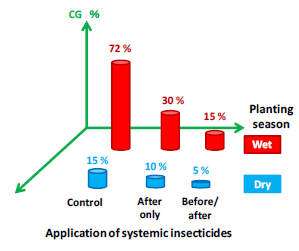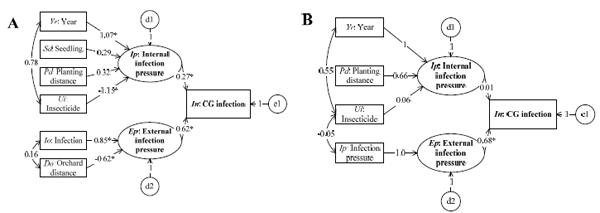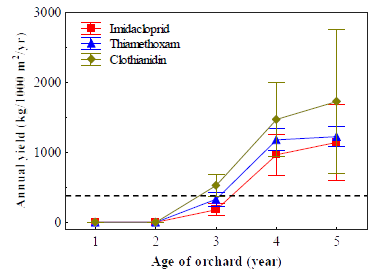Citrus greening management for king mandarin cultivation in southern Vietnam
Description
Citrus greening (CG) has destroyed extensive citrus areas in Asian countries. Recent studies have revealed that the control of the psyllid vector, Diaphorina citri, using systemic insecticides such as imidacloprid, thiamethoxam or clothianidin, effectively reduces the occurrence of this disease. These insecticides are grouped as neonicotinoids. However, economic evaluation of this control has not been done yet, making farmers reluctant to follow it. Furthermore, even if this control is carried out, orchards would have to be abandoned under some special circumstances. Hence, our studies were attempted 1) to analyse the impact of risk factors on the occurrence of this disease, 2) to evaluate the efficacy of the above management, and 3) to estimate the contribution of the management to the farmers’ economy.
Field assessment in which the cultivation of king mandarin was surveyed among farmers in southern Vietnam revealed that more than 70% of the orchards had been infected by CG. Covariance structure analysis was applied to the data of the study for the extraction of factors that were effectively linked with the occurrence of CG. The analysis revealed that the ambient influence was two to three times stronger than control efforts within the orchard. Thus, orchards located less than 50 m from infected orchards would be facing a higher risk of the disease invasion. In other words, if there are no infected trees within this distance from an orchard, the effort required for disease management would be effectively reduced.
The efficacy of neonicotinoids with the changes of planting seasons was evaluated. Seedlings planted in the season when psyllids increased, usually from April to July corresponding to the wet season, would be infected 70% by CG in one and a half years if no neonicotinoids were used, and 30% with the use of any of these insecticides (Fig. 1). The infection proportion was effectively reduced to 15% if seedlings were treated with neonicotinoids both 10 days before planting and every two months after planting. On the other hand, the CG infection proportion was surprisingly reduced if seedlings were planted in the season when the psyllid density was decreased. Seedlings were infected only 15% without the use of neonicotinoids, 10% with the application of neonicotinoid only after planting, and 5% with the insecticide application both before and after planting.
Based on these results, a diagram for decision-making on the cultivation of king mandarin was devised (Fig. 2). On this diagram, a farmer has to first observe the distance of his new orchard from the nearest neighbouring orchard. If the distance is more than 50 m, he can plant seedlings anytime in the year without the pre-planting application of insecticides, although the use of insecticides would promise better yields. If an infected old orchard is located within 50 m, seedlings should be planted in the season when psyllid densities are low. In this case, there is no need to apply neonicotinoids before planting. If seedlings are planted in the season when the psyllid density is high, neonicotinoids should be applied both before and after planting.
Finally, the efficiency of the management on the farmers' household economy was evaluated from studies, in which both CG infection and farm households' economy were investigated. The first crop of king mandarin is expected one and a half years after planting in southern Vietnam. In other word, farmers who cultivate this cultivar must wait for a couple of years until they can gain enough income from the cultivation for their livelihood. In this region, 20 thousand dong per year would be required for their basic subsistence. The average acreage of farms in southern Vietnam is about five thousand square metres, indicating that the minimal annual yield should be four million dong per one thousand square metres for the average farmers. This amount is equivalent to an annual yield of 400 to 500 kg/1000 m2. Our model farmers attained this level of fruit production in the third year (Fig. 3). In fact, some farmers who were suffering from indebtedness before this project repaid their debts in full and started to earn more income to purchase new furniture or repair their houses. This indicates that the developed management could be extended to other farmers in southern Vietnam.
After completion of the project, the techniques developed have been further continued in the JICA project which is attempting to facilitate the economic independence of farmers in southern Vietnam. This project will help the farmers to follow the techniques successfully in the cultivation of king mandarin. We hope that the CG management developed in our project would be extended over southern Vietnam and the production of king mandarin would be further raised for the farmers' economic independence.
Figure, table
-
Fig. 1.
The proportion of king mandarin trees infected by citrus greening 1.5 year after planting. These trees were planted either in the dry season, May 2007 when the psyllid density was high in the year or in the wet season, November 2007 when the density was low. Seedlings were treated either with no neonicotinoids designated as control or by these insecticides. The insecticide applications were either performed only after planting or both before and after planting. -
Fig. 2.
Model examined by covariance structure analysis of data obtained in 2008 in southern Vietnam (A) and in 2009 in Vinh Long (B). Observed variables are designated by rectangles and latent variables by ellipses. Error terms and disturbance variables are shown by circles. The data were standardized for these analyses and coefficients of dependent variables are shown as numerals on the arrows. Asterisks indicate significant coefficients at P < 0.05. -
Fig. 3.
Economic gains of farmers who employed the management of CG developed by us. Dashed line indicates the average income required for the basic livelihood of a farm household in southern Vietnam. Bars indicate the standard error of the means. -
- Affiliation
-
Japan International Research Center for Agricultural Sciences Tropical Agriculture Research Front
- Classification
-
Research A
- Term of research
-
FY2006~2010
- Responsible researcher
-
ICHINOSE Katsuya ( Tropical Agriculture Research Front )
YONEMOTO Yoshimi ( Tropical Agriculture Research Front )
Ogata Tatsushi ( Tropical Agriculture Research Front )
MIERUKA ID: 001788Kobori Youichi ( Tropical Agriculture Research Front )
OHTO Yasuo ( Tropical Agriculture Research Front )
NAKATA Tadafumi ( Tropical Agriculture Research Front )
SEKINO Koji ( Tohoku Agricultural Research Center, NARO )
TUAN Do Hong ( Southern Fruit Research Institute )
- ほか
- Publication, etc.
-
Ichinose, Katsuya, et al. "Effective use of neonicotinoids for protection of citrus seedlings from invasion by Diaphorina citri (Hemiptera: Psyllidae)." Journal of economic entomology 103.1 (2010): 127-135.
Ichinose, Katsuya, et al. "Unreliable pesticide control of the vector psyllid Diaphorina citri (Hemiptera: Psyllidae) for the reduction of microorganism disease transmission." Journal of Environmental Science and Health Part B 45.5 (2010): 466-472.
Kobori et al. (2011) Appl Entomol Zool. 46:27-30.
Ichinose et al. (2011) JIRCAS Working Report 72.
- Japanese PDF
-
2010_seikajouhou_A4_ja_Part4.pdf105.53 KB



